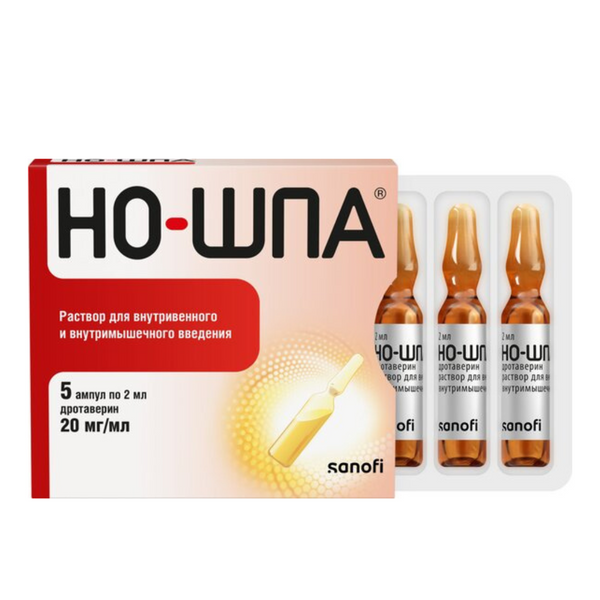|
Quantity
|
Out of stock
|
||
|
|
|||
Pharmacological action
Myotropic antispasmodic.
Reduces the tone of smooth muscles of internal organs, reduces their motor activity, moderately dilates blood vessels.
In terms of the severity and duration of the antispasmodic effect, it is superior to papaverine. Does not affect the autonomic nervous system and the central nervous system.
Due to the fact that No-shpa acts directly on smooth muscles, it can be used as an antispasmodic in cases where drugs from the group of anticholinergics are contraindicated (glaucoma, prostatic hypertrophy).
When administered intravenously, the effect of the drug appears after 2-4 minutes. The maximum effect develops after 30 minutes.
Pharmacokinetics
Absorption
When taken orally, drotaverine hydrochloride is quickly absorbed from the gastrointestinal tract, the half-absorption period is 12 minutes. Bioavailability is about 100%. Cmax in serum is achieved in 45-60 minutes.
Distribution
Drotaverine hydrochloride does not penetrate the blood-brain barrier.
Metabolism
Drotaverine hydrochloride is biotransformed in the liver.
Excretion
After 72 hours, it is almost completely excreted from the body in the form of metabolites - 50% with urine and 30% with feces.
Indications
- prevention and treatment of functional conditions and pain syndrome caused by smooth muscle spasm (including spasms of the gastrointestinal tract, urinary tract associated with cholelithiasis, cholecystitis, gastric ulcer, duodenal ulcer; spasm of the pyloric and cardiac part of the stomach; spastic constipation, spastic colitis; proctitis, tenesmus; postoperative colic due to gas retention; due to nephrolithiasis, pyelitis; due to instrumental interventions);
– algomenorrhea;
– to reduce uterine excitability during pregnancy; in case of spasm of the cervix during labor, prolonged dilation of the cervix, postpartum contractions, threatened abortion;
– spasms of peripheral vessels (including endarteritis);
– prevention of smooth muscle spasm during instrumental examination methods.
Instructions for use / dosage
Orally, subcutaneously and intravenously. Subcutaneously or intramuscularly, for adults: 40-240 mg in 1-3 doses per day; to relieve acute nephrolithiasis and/or gallstone colic: 40-80 mg intravenously, slowly;
other abdominal spastic pain: 40-80 mg intramuscularly or subcutaneously, if necessary up to 3 times per day (no more), followed by a transition to oral administration of 120-240 mg;
spasm of the cardia or esophagus: 80 mg intramuscularly.
Orally, adults: 120-240 mg in 2-3 doses. Children: from 1 to 6 years old - 40-120 mg in 2-3 doses, over 6 years old - 80-200 mg in 2-5 doses.
Side effects
Possible: dizziness, palpitations, feeling of heat, increased sweating.
With intravenous administration, cases of decreased blood pressure (up to collapse), development of AV block, occurrence of arrhythmias, depression of the respiratory center have been noted.
Contraindications
- hypersensitivity to the drug.
Pregnancy and lactation
Use No-shpa with caution during pregnancy and lactation (breastfeeding).
Special instructions
Caution should be exercised when prescribing the drug to patients with severe atherosclerosis of the coronary arteries.
No-shpa can be used as part of combination therapy to relieve a hypertensive crisis.
In the treatment of gastric ulcer and duodenal ulcer, No-shpa is used in combination with anticholinergics.
Overdose
To date, there have been no reports of No-shpa overdose.
Drug interactions
When used simultaneously, No-shpa can reduce the antiparkinsonian effect of levodopa.
Storage conditions and periods
The drug should be stored in a place protected from light, in a tightly closed package at a temperature of 15° to 25°C. Shelf life is 5 years.
































